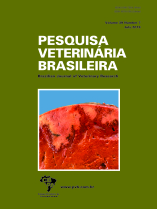 |
|
|
|
Year 2019 - Volume 39, Number 7
|

|
Oral lesions and retroviruses in shelter cats, 39(7):516-522
|
ABSTRACT.- Silva A.P., Flores M., Mazaro R., Luz F., Silva M. & Fighera R.A. 2019. Oral lesions and retroviruses in shelter cats. [Afecções orais e retroviroses em gatos de abrigo.] Pesquisa Veterinária Brasileira 39(7):516-522. Hospital Veterinário Universitário, Universidade Federal de Santa Maria, Avenida Roraima 1000, Camobi, Santa Maria, RS 97105-900, Brazil. E-mail: apsvet@hotmail.com
Oral lesions are common problems in feline medicine worldwide, and may be associated with different causes, such as infectious agents. There are only a few studies reporting the chief oral diseases and the results for retrovirus tests in shelter cats in Brazil, especially in the South region. This study aimed to identify the main inflammatory oral lesions in shelter cats and verify the test results for feline immunodeficiency virus (FIV) and feline leukemia virus (FeLV) infections. Forty-three felines from private shelters in the central region of Rio Grande do Sul state (RS) that presented clinically evident oral lesions, regardless of age, breed, sex, and neuter status, were used in this survey. Serological tests for FIV and FeLV were performed in all cats, and data regarding the rearing system were collected. Sixteen cats (37.2%) were reared in a free system, whereas 27 (62.8%) were kept under a restrict system. Of the 43 cats with oral lesions, 29 (67.44%) presented only one type of lesion, characterized as periodontitis (n=22, 51.16%), followed by gingivitis (n=6, 13.95%), and stomatitis (n=1, 2.32%). Concomitant stomatitis and periodontitis were found in the 14 remaining cats (100%). With respect to the test results for retrovirus infections, nine (20.93%) of the 43 felines were positive for FIV alone. Co-infection with both viruses was observed in seven cats (16.28%). No cat was seropositive for FeLV valone. None of the six cats that presented gingivitis was positive for FIV and FeLV; one cat with stomatitis was positive for FIV and FeLV; of the 22 cats with periodontitis, six (27.27%) were FIV positive and two (9.09%) were FIV/FeLV positive; and of the 14 cats that presented stomatitis and periodontitis, three (21.43%) were FIV positive and four (28.57%) were FIV/FeLV positive. As for diagnosis, 28 cats (65.1%) presented solely periodontal disease (PD), one cat (2.32%) had feline chronic gingivostomatitis (FCG) alone, and 14 (32.5%) had both PD and FCG. The results obtained show that the main oral lesions found in shelter cats in the central region of RS were gingivitis, stomatitis, and periodontitis. Periodontitis, in association or not with stomatitis, was the most frequently observed oral cavity lesion in FIV- and/or FeLV-positive cats. Other factors may contribute to installation of inflammatory oral diseases in shelter cats because most cats with oral cavity lesions tested negative for retrovirus infections. |
| |
|
|
| |
|
 |